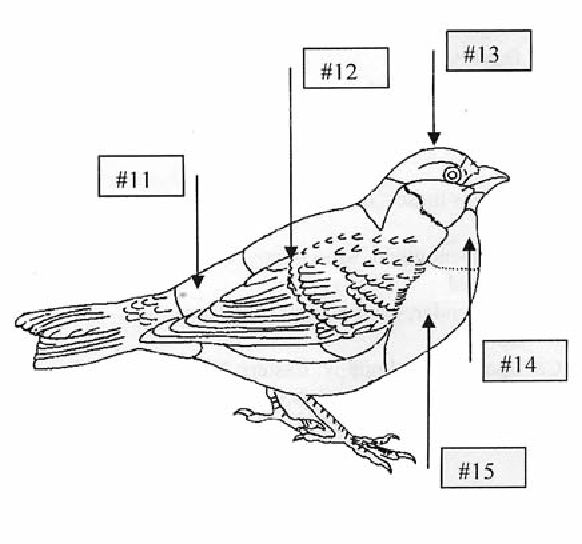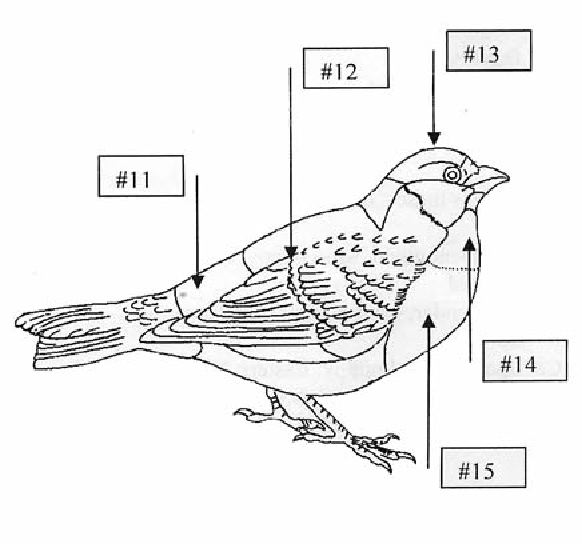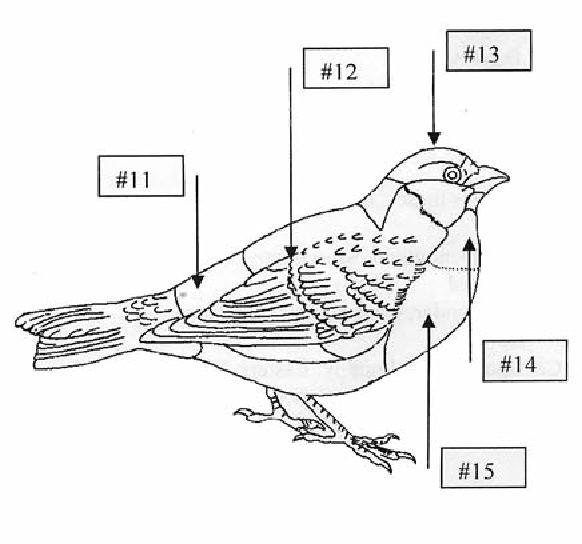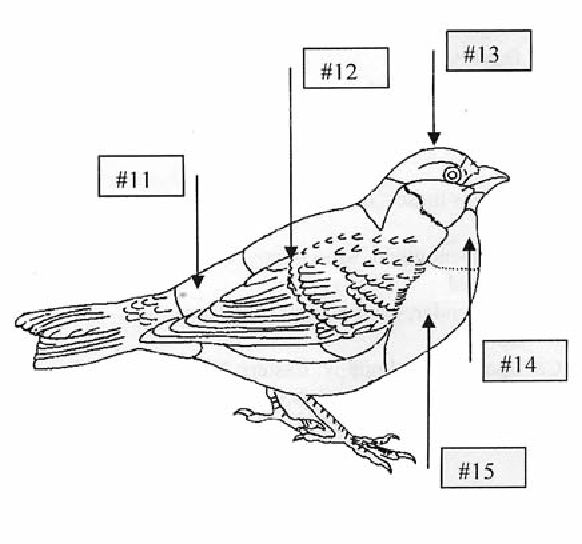Multiple Choice
Identify the choice that
best completes the statement or answers the question.
|
|
|
1.
|
What is #11 called? 
|
|
|
2.
|
What is #12 called?  a. | Primary feather | b. | Wingbar | c. | Flank |
|
|
|
3.
|
What is #13 called? 
|
|
|
4.
|
What is #14 called? 
|
|
|
5.
|
What is #15 called? 
|
|
|
6.
|
Arriving the middle of March in Ohio, the male is very territorial. Other males
trying to take over his territory will display yellow or no color on their wings.
a. | Eastern Bluebird | d. | Cedar Waxwing | b. | Red-winged Blackbird | e. | Barn Swallow | c. | Sharp-shined
Hawk |
|
|
|
7.
|
Which composes Ohio’s bedrock?
a. | Metamorphic | d. | Glacial till | b. | Igneous | e. | All of these are correct | c. | Sedimentary |
|
|
|
8.
|
Which of these guidelines provides more effective interpretive signs?
a. | Eliminating headings of titles | b. | Including simple illustrations
| c. | Capitalizing all text | d. | using a font of 8 point of
smaller | e. | Including simple illustrations and using a font of 8 point of
smaller |
|
|
|
9.
|
Which of the petals does Purple cress have?
a. | 3 | c. | 5 | e. | more than 6 | b. | 4 | d. | 6 |
|
|
|
10.
|
What is another name for Trout lily?
a. | Adder’s tongue | b. | Daylily | c. | Dogtooth
violet | d. | Adder’s tongue and Dogtooth violet | e. | none of these are
correct |
|
|
|
11.
|
Which lists these salamanders in order of smallest to largest?
a. | Small-mouthed, mud puppy, hellbender, spotted | b. | Hellbender, mud
puppy, small-mouthed, spotted | c. | Spotted, mud puppy, eastern newt,
hellbender | d. | Red-backed, spotted, mud puppy, hellbender | e. | Mud puppy, spotted,
red-backed, hellbender |
|
|
|
12.
|
Which is an accipiter?
a. | Red-tailed hawk | d. | American kestrel | b. | Osprey | e. | Bald eagle | c. | Sharp-shinned
hawk |
|
|
|
13.
|
Which can be commonly founded at winter bird feeders in Ohio?
a. | Cardinal, Chickadee, cowbird, robin | b. | Downy woodpecker, tufted titmouse,
junco | c. | Junco, Yellowthroat, Flicker | d. | Starling, Song sparrow,
kingbird | e. | Cowbird, Red-winged blackbird, house sparrow |
|
|
|
14.
|
The dark-eyed junco is in which family?
a. | Tanager | c. | Warbler | e. | Sparrow | b. | Chickadee | d. | Blackbird |
|
|
|
15.
|
Which owl can be found in Ohio in the summer?
a. | Long-eared | c. | Short-eared | e. | Screech and
Barn | b. | Screech | d. | Barn |
|
|
|
16.
|
You find twigs eaten off of some apple tree seedlings about a foot off the
ground. One side is cut neatly and the other is roughly torn. Which animal is most likely the one who
did this?
a. | Eastern cottontail | c. | White-tailed deer | e. | Eastern
chipmunk | b. | Meadow vole | d. | Striped skunk |
|
|
|
17.
|
Which of these animals hibernates?
a. | Short-tailed shrew | c. | Eastern cottontail | e. | Eastern gray
squirrel | b. | Woodchuck | d. | Raccoon |
|
|
|
18.
|
Living history interpretation can include demonstrations on
a. | religious beliefs | d. | all of the choices are correct | b. | contemporary
lifestyles | e. | none of these
are correct | c. | historical lifestyles |
|
|
|
19.
|
Which is the smallest venomous snake found in Ohio?
a. | Eastern Massasauga | d. | timber rattlesnake | b. | Ring-necked snake | e. | none of these are correct | c. | copperhead |
|
|
|
20.
|
What is the tympanum?
a. | Poisonous sac in a rattlesnake | b. | Fruiting body of
jack-in-the-pulpit | c. | Covering on a flower before it
opens | d. | Ear membrane of a frog | e. | Membrane inside of a bird’s
egg |
|
|
|
21.
|
Which list includes only rodents?
a. | Rabbit, Deer, Vole | b. | Vole, Mouse, Squirrel | c. | Squirrel, Deer,
Vole | d. | Mole, Mouse, Squirrel | e. | Rabbit, Squirrel,
Mouse |
|
|
|
22.
|
Which animal is diurnal?
a. | Skunk | d. | Flying squirrel | b. | Barn owl | e. | Thirteen-lined ground
squirrel | c. | Raccoon |
|
|
|
23.
|
Which is a true statement about owls?
a. | One ear is higher than the other on the side of their heads. | b. | Their eyes move
easily within their head. | c. | The facial disk helps the owl pick up
sounds. | d. | One ear is higher than the other on the side of their heads and the facial disk helps
the owl pick up sounds are true. | e. | None of these are
true |
|
|
|
24.
|
What activity helps birds repair and maintain their feathers?
a. | Preening | c. | Dustbathing | b. | Primping | d. | Drumming |
|
|
|
25.
|
What does sexual dimorphism mean?
a. | Animal of one sex displays the sexual organs of the other sex. | b. | Animal has both male
and female parts. | c. | Male and female cannot be told apart without
studying internal parts. | d. | The sex of the animal cannot be determined
until the second year. | e. | Males display different colors than
females. |
|
|
|
26.
|
In March,these birds can be seen soaring in pairs and sitting high in trees.
They are preparing to nest in large, stick nests that are sometimes also utilized by Great horned
owls.
a. | Screech owl | d. | Sharp-shinned hawk | b. | Bald eagle | e. | Turkey vulture | c. | Red-tailed
hawk |
|
|
|
27.
|
With a pair of 7x35 binoculars:
a. | The subject appears 35 times larger than without magnification. | b. | The subject is
enlarged five times from 7’ to 35’ | c. | The front lens opening is 35
mm. | d. | The subject appears seven times larger than without
magnification. | e. | The front lens opening is 35mm and the subject appears seven times larger than
without magnification. |
|
|
|
28.
|
Which is an example of anthropomorphism?
a. | Bambi crying when his father was killed | b. | White-tailed deer
removing velvet from their antlers | c. | A nest of Eastern cottontail being killed by
predators | d. | Green-winged teal migrating south | e. | Red fox marking its
territory |
|
|
|
29.
|
How much of Ohio is glaciated?
a. | 10% | b. | 33% | c. | 50% | d. | 66% | e. | 100% |
|
|
|
30.
|
Which plant is a favorite food source for Monarch larvae?
a. | Common Mullein | d. | Goldenrod | b. | Blur Phlox | e. | Wild Carrot | c. | Common
Milkweed |
|
|
|
31.
|
Which plant causes serious allergic reaction in many people in late summer/early
fall?
a. | Common Ragweed | b. | Golden Ragwort | c. | Goldenrod | d. | Common Ragweed and
Goldenrod | e. | Common Ragweed,Golden Ragwort and Goldenrod |
|
|
|
32.
|
What does precocial mean?
a. | Males return from winter range prior to the females | b. | Young are ready to
leave nest within a day or so of hatching | c. | Females raise the young without the male
| d. | Plant flowers before leaves come out | e. | None are the correct
answer |
|
|
|
33.
|
What is the maximum amount of animals an ecosystem can sustain over a period of
time?
a. | Limiting factor | d. | Biomass | b. | Maximum potential | e. | Ecosystem maximum | c. | Carrying
capacity |
|
|
|
34.
|
What signals a bird to begin migration?
a. | Length of sunlight | b. | Temperature | c. | Lack of
food | d. | All are correct | e. | Only Length of sunlight and
Temperature |
|
|
|
35.
|
Which term refers to an animal that is active at dusk and dawn?
a. | Altricial | c. | Diurnal | e. | Crepuscular | b. | Nocturnal | d. | Biurnal |
|
|
|
36.
|
The following are in the Mint family.
a. | Wild ginger, Hawkweed, Heal-all | b. | Ground-ivy, Wild bergamot,
Heal-all | c. | ground-ivy, Tall meadow-rue, Chicory | d. | Heal-all, Tall meadow-rue, Wild
geranium | e. | Wild geranium, Wild ginger, Hawkweed |
|
|
|
37.
|
Which animal paralyzes its prey with its bite?
a. | Striped skunk | d. | Short-tail shrew | b. | Starnose mole | e. | Hoary bat | c. | Woodland jumping
mouse |
|
|
|
38.
|
The following normally bloom in the spring.
a. | Purple cress, Purple loosestrife, Common milkweed | b. | Large-flowered
bellwort, False Solomon’s seal, Trout lily, Wild carrot | c. | Mayapple, Yarrow,
Round-lobed hepatica, purple cress | d. | Large-flowered bellwort, Mayapple, Squirrel
corn, Bloodroot | e. | Large flowered trillium, Blazing star, Butterfly weed, Trout
lily |
|
|
|
39.
|
Which plant is also known as Cranesbill because its seed looks like a
bill?
a. | Purple cress | d. | Great lobelia | b. | Wild geranium | e. | Round-lobed hepatica | c. | Ground-ivy |
|
|
|
40.
|
The following have primarily yellow flowers.
a. | Golden Ragwort, Large-flowered bellwort, Trout lily, Marsh
marigold | b. | Butter and eggs, Heal-all, Wild onion, Daylily | c. | Large-flowered
bellwort, Large-flowered trillium, Prairie dock | d. | Marsh marigold, Golden Ragwort, Wild onion,
Heal-all | e. | Butter and eggs, Wood lily, ground ivy, Yellow lady’s
Slipper |
|
Matching
|
|
|
Match the amphibians with the description of their call: a. | Explosive, two-syllable sound string heard late April though June | b. | Long musical trill
heard from mid-March to early June. | c. | Deep, three syllable song heard starting in
mid-May | d. | Long, low guttural note followed by several short notes. | e. | Short, shrill sound
heard in March. |
|
|
|
41.
|
Green frog
|
|
|
42.
|
Northern leopard frog
|
|
|
43.
|
American toad
|
|
|
44.
|
Spring peeper
|
|
|
45.
|
Bullfrog
|
|
|
Match sex and age: a. | Immature | b. | Mature | c. | Male | d. | Female | e. | Does not determine age or
sex |
|
|
|
46.
|
Red stripe found below the bill on the Pileated Woodpecker
|
|
|
47.
|
Screech owl feather are gray instead of red.
|
|
|
48.
|
Carapace of Eastern box turtle is flat, not concave.
|
|
|
49.
|
There is no red on the back of the head of a Downy Woodpecker.
|
|
|
50.
|
When picked up, the American toad makes noise of protest.
|